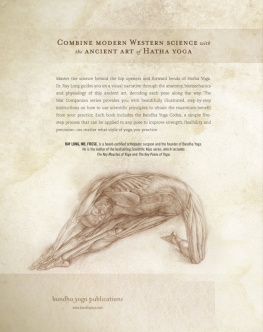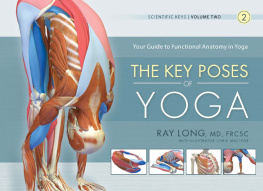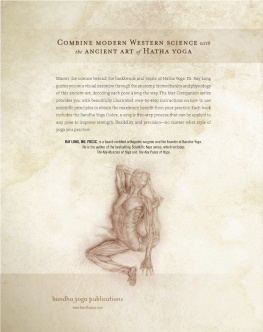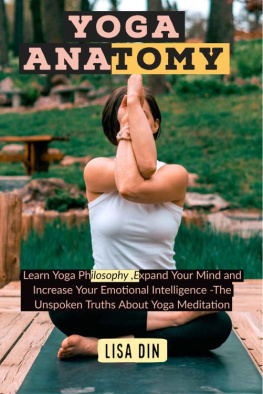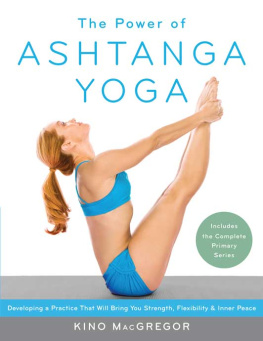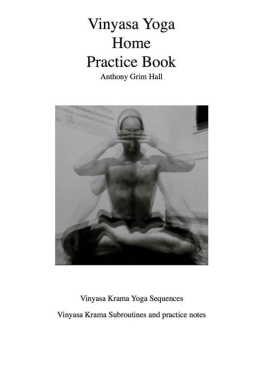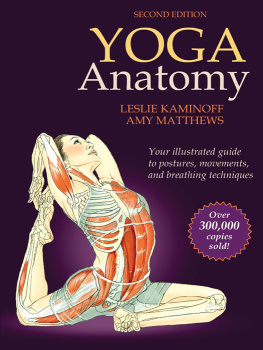Ray Long - Yoga Mat Companion 1: Anatomy for Vinyasa Flow and Standing Poses
Here you can read online Ray Long - Yoga Mat Companion 1: Anatomy for Vinyasa Flow and Standing Poses full text of the book (entire story) in english for free. Download pdf and epub, get meaning, cover and reviews about this ebook. year: 2010, publisher: Bandha Yoga Publications, genre: Romance novel. Description of the work, (preface) as well as reviews are available. Best literature library LitArk.com created for fans of good reading and offers a wide selection of genres:
Romance novel
Science fiction
Adventure
Detective
Science
History
Home and family
Prose
Art
Politics
Computer
Non-fiction
Religion
Business
Children
Humor
Choose a favorite category and find really read worthwhile books. Enjoy immersion in the world of imagination, feel the emotions of the characters or learn something new for yourself, make an fascinating discovery.
- Book:Yoga Mat Companion 1: Anatomy for Vinyasa Flow and Standing Poses
- Author:
- Publisher:Bandha Yoga Publications
- Genre:
- Year:2010
- Rating:3 / 5
- Favourites:Add to favourites
- Your mark:
- 60
- 1
- 2
- 3
- 4
- 5
Yoga Mat Companion 1: Anatomy for Vinyasa Flow and Standing Poses: summary, description and annotation
We offer to read an annotation, description, summary or preface (depends on what the author of the book "Yoga Mat Companion 1: Anatomy for Vinyasa Flow and Standing Poses" wrote himself). If you haven't found the necessary information about the book — write in the comments, we will try to find it.
Yoga Mat Companion 1: Anatomy for Vinyasa Flow and Standing Poses — read online for free the complete book (whole text) full work
Below is the text of the book, divided by pages. System saving the place of the last page read, allows you to conveniently read the book "Yoga Mat Companion 1: Anatomy for Vinyasa Flow and Standing Poses" online for free, without having to search again every time where you left off. Put a bookmark, and you can go to the page where you finished reading at any time.
Font size:
Interval:
Bookmark:

bandha yoga publications
This book is intended as a reference volume only, not as a medical manual. It is not to be used in any manner for diagnosis or treatment of medical or surgical conditions. This book is also not intended to be a substitute for any treatment that may be or has been prescribed by your health care provider. If you suspect that you have a medical problem, consult your physician. Always, in your particular case, obtain medical clearance from your physician before beginning the practice of yoga or any other exercise program. Always practice yoga under the direct guidance and supervision of a qualified and experienced instructor. Working directly with a qualified yoga instructor can help to prevent injuries. The author, illustrators, editor, publisher and distributor specifically disclaim any responsibility or liability for injuries that may occur during the practice of yoga or any other exercise program.
Published by Bandha Yoga Publications
Plattsburgh, NY
www.bandhayoga.com
Copyright 2010 Raymond A. Long, MD, FRCSC
All content, visual and textual, produced under the direction of Ray A. Long, MD, FRCSC
All rights reserved.
No part of this book may be reproduced, stored in a retrieval system, or transmitted by any means, electronic, mechanical, photocopying, recording, or otherwise, without written permission from the publisher.
Mat Companion is a registered trademark.
Distributed by Greenleaf Book Group LLC
For ordering information or special discounts for bulk purchases, please contact Bandha Yoga Publications at 8908 Center Pointe Drive, Baldwinsville, NY 13027, 518.578.3720
Design and composition by Greenleaf Book Group LLC
Cover design by Greenleaf Book Group LLC
Front and back cover illustrations by Kurt Long, BFA www.kurtlong.net
Computer Graphics Technical Director: Chris Macivor
Sanskrit calligraphy and border painting: Stewart Thomas www.palmstone.com
Editor: Eryn Kirkwood, MA, RYT www.barrhavenyoga.com
ISBN 13: 978-1-60743-943-1
Part of the Tree Neutral program, which offsets the number of trees consumed in the production and printing of this book by taking proactive steps, such as planting trees in direct proportion to the number of trees used: www.treeneutral.com

Printed in Canada on acid-free paper
10 11 12 13 14 15 10 9 8 7 6 5 4 3 2 1
First Edition
The mat companion series is designed to assist you in understanding the functional anatomy of yoga. Although all yoga poses are interrelated, for learning purposes we have subdivided them into categories according to their general form. This first book of the series shows how to combine Western scientific knowedge with the practice of Vinyasa Flow and the standing poses. In Vinyasa we repeat a foundational series of postures that encircle individual asanas from the other pose categories. This vigorous and aerobic practice combines breathing and body movement to produce heat, warming up the muscles, tendons, and ligaments and generating a detoxifying sweat. Practicing Vinyasa in a heated room enhances these effects. In the first part of this book, we discuss the practical application of Western science to Vinyasa Flow.
Following the Vinyasa portion of the book are the standing poses. Learning Hatha Yoga begins with these fundamental postures, which stretch and strengthen the muscles of the lower extremities and open the hips and pelvis. As a result of this practice, activities of daily living, such as standing and walking, feel comfortable and easy. Working the muscles and joints of the lower extremities also stimulates the nerve centers that supply this region, increasing electrical activity in the lumbosacral plexus. This increased electrical activity in turn illuminates the first and second chakras of the subtle body, aiding to remove energetic blockages that develop throughout our lifetime. It is this combination of biomechanical, physiological, and energetic processes that differentiate yoga from other forms of physical activity.
Practicing yoga is like passing through a series of doors, with each door revealing new possibilities in the poses. The key to unlocking the first door is understanding the joint positions. This understanding can be used to identify the muscles that create the form of the pose and those that stretch. The key to positioning the joints is engaging the correct muscles. This begins with the prime movers. Engage the prime movers and the bones will align. The key to deepening the asanas is using your understanding of physiology to lengthen the muscles that stretch in the pose. Focus on these keys and the postures will automatically fall into place and manifest the beneficial effects of yoga. These include improved flexibility, heightened awareness, a sense of well-being, and deep relaxation.
The Mat Companion series is a set of modular books. Each book focuses on a specific pose category and contains the following:
- The Key Concepts: a description of biomechanical and physiological principles with applications for specific poses.
- The Bandha Yoga Codex: a simple five-step process that can be used to improve your flexibility, strength, and precision in the asanas.
- The Pose Section: a detailed description of the individual postures.
- Movement Index: explanations of body movement and tables listing the muscles associated with each movement.
- Anatomy Index: a visual listing of bones, ligaments, and muscles (showing the origins, insertions, and actions of each).
- Glossary of Terms
- Sanskrit Pronunciation and Pose Index
- English Pose Index

FIGURE 1 The Key Concepts show you how to apply biomechanics and physiology to your poses. Read this section first and return here often to refresh your knowledge.

FIGURE 2 The opening page for each pose illustrates the basic joint actions and positions of the body for that particular asana. Sanskrit and English names are provided for each posture. Use this page to assist you in learning the basic form of the pose and other concise details.

FIGURE 3 Use the preparatory section as a guide for how to enter the pose. If you are new to yoga or feel a bit stiff, use one of these modifications for your practice. In general the preparatory poses affect the same muscle groups as the final asana. You will benefit from the pose no matter which variation you practice.
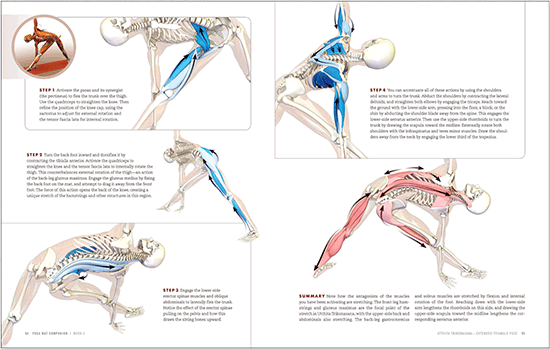
FIGURE 4 Each pose comes with a series of steps for engaging the muscles that position the joints, concluding with a summary of the muscles that stretch. Muscles that contract are colored different shades of blue (with the prime movers deep blue), and those that stretch are red. Use the pose section to master the anatomy of any given asana.
Next pageFont size:
Interval:
Bookmark:
Similar books «Yoga Mat Companion 1: Anatomy for Vinyasa Flow and Standing Poses»
Look at similar books to Yoga Mat Companion 1: Anatomy for Vinyasa Flow and Standing Poses. We have selected literature similar in name and meaning in the hope of providing readers with more options to find new, interesting, not yet read works.
Discussion, reviews of the book Yoga Mat Companion 1: Anatomy for Vinyasa Flow and Standing Poses and just readers' own opinions. Leave your comments, write what you think about the work, its meaning or the main characters. Specify what exactly you liked and what you didn't like, and why you think so.


